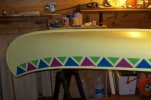One problem with using triangular templates or stencils to lay out a triangular design such as OT's design # 4 arises from inevitable errors in measurement. It is difficult to get a precise measurement of the curved sheer line of a canoe, and any error in the dimension of a triangular template baseline will be multiplied by the number of times the template is used. For example, if painting design #4 on a hypothetical 18' canoe (216"), with a hypothetical sheer line of 202" requires 43 large triangles under the gunwale, each triangle base will be 4.7 inches. If an error as small as 1/32' is made in creating the template, the accumulated 1/32" error of 43 triangles will be 1 and 11/32" -- more or less.
The trick is to distribute this one large error into many small errors which are essentially invisible.
I have used a method that does not require using templates, and accommodates and hides small errors. All that is needed is a tape measure, a small square (or square-cut piece of cardboard or wood), masking tape, a pencil or washable marker, and a small sharp knife to cut the masking tape.
First, determine the size of the triangle you wish to use -- for the hypothetical canoe above with a 202" sheer line under the gunwales, the base of the hypothetical triangle will be about 4.7" and its height will be 3".
Next, determine the center of the sheer under the gunwale and mark with a pencil. Then, mark the ends of a line 4.7" long centered on that marked center. These two points will identify the base of your first, central triangle -- leaving you with the bases of 21 triangles to mark out on each side of the central one.
But do not now measure 21 bases one after the other.
Instead, mark the ends of a 4.7" triangle base at both the bow and at the stern -- leaving you now with 20 triangles to place between the central triangle nd each of these end triangles.
Then divide this 20 triangle distance distance in half, giving you a space into which 10 triangles will fit. Mark the center of this space, and you now have eight segments with the space for five triangles.
Now, for each of these 8 segments, meaure the distance and divide by 5, and mark the 5 triangle bases along the gunwales (see pencil marks in the 3d photo below). Do this separately for each or the 8 segments -- the distance for each will not likely be exactly the same, but the difference will be negligible. And then when actually marking out the 5 triangle bases with your pencil in each of the 8 segments, minor fudging is easily done by eye if needed so the five triangles equally fill the segment.
Next, mark a line 3" below the sheer under the gunwale -- I made a series of pencil dots using a short story stick, and then following a fair curve, connected them with masking tape. First and second photos below.
Now go back to each of your 43 triangle bases, and mark the center of each. Locating your square from this point, mark the apex point of your triangle below on the masking tape. (As seen in the photo, I marked the base of each triangle and its center on the gunwale, which was to be painted over.)
With masking tape, connect the ends of the base of each triangle under the gunwales with the apex point marked on the masking tape 3" below, photo 3. The tape now defines the larger triangles which touch each other under the gunwales, as well as the smaller trangles which are not connected.
Paint the triangle with whatever color(s) you are using. When the masking tape is removed, you will have your triangles defined by the base color of the hull. The broad band of blue maksing tape was simply to guard against drips and smears.
This paint job was an adaptation of design #4 -- obviously, the colors are not the classic red, white, and blue. Further, my small (green) triangles are not separated from the larger triangles as much as in the classic design, and they are not as small as in the classic design. Had I used wider masking tape, I could have come very close to the proportions of the classic design.
Also, I did not put triangles on the curve of the stems -- but I think this method could be readily adapted to a curved line, or the usual template method could be used -- only a few triagles can fit along the curve of a stem, and small errors in placing templates should not be visible.
This all seems like a lot of work, but it is not difficult. From what I have read, using templates is probably at least as much work. I have never tried using templates, so I cannot say that this method is easier or better -- but it does get the job done.







